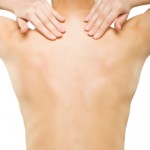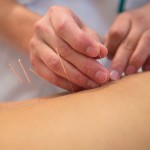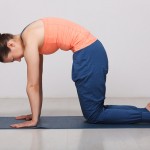

 Well over 60 million Americans suffer from back pain and for many people it is specifically upper back pain that disrupts their life; however, relief can be found through natural treatments and exercise.
Well over 60 million Americans suffer from back pain and for many people it is specifically upper back pain that disrupts their life; however, relief can be found through natural treatments and exercise.
When someone complains about upper back pain, it is likely they are experiencing discomfort throughout the backside of the chest and upper abdominal area. The upper back includes the shoulder blades and the area where the rib cage connects to the spine. The upper back is often called the “Thoracic spine.”
Although it doesn’t happen as often as lower back pain, upper back pain can be very uncomfortable and it can be chronic. There are multiple nerves, muscles, tendons and ligaments in the upper back. When any of these become irritated or inflamed, upper back pain can be the result.
 Inflammation and irritation in the upper back takes place for a number of different reasons. For some people it is as simple as poor posture, for others it can be trauma due to an accident or sports injury. There are also medical conditions including herniated disc, arthritis, spinal degeneration, spinal stenosis, spondylitis, kidney stones or bone cancer that can lead to upper back pain. In most cases, upper back pain is associated with muscle irritation from poor posture or joint problems, which are not reasons to panic.
Inflammation and irritation in the upper back takes place for a number of different reasons. For some people it is as simple as poor posture, for others it can be trauma due to an accident or sports injury. There are also medical conditions including herniated disc, arthritis, spinal degeneration, spinal stenosis, spondylitis, kidney stones or bone cancer that can lead to upper back pain. In most cases, upper back pain is associated with muscle irritation from poor posture or joint problems, which are not reasons to panic.
So back pain is back pain, right? Well, not exactly. Not all symptoms of upper back pain are focused on the backside of the chest and upper abdominal area. There are other signs associated with back pain. Upper back pain with difficulty breathing may be a sign of heart attack, while upper back pain with a fever could be a sign of an infection.
Here are some other symptoms that are common with upper back pain:
If you or someone you know is experiencing the following symptoms with back pain, immediate medical attention is required.
The upper back involves important elements of the spine. The spine is made of vertebrae that control our head movements and support our upper body structure. Upper back pain can begin in the neck and back area and radiate into the shoulders, arms and hands.
If you suffer from upper back pain between the shoulder blades, the first course of action should be to review your activities. Ask yourself if you have done any heavy lifting or sports activities that could have irritated muscles or tendons. If you recently began a new exercise routine, it could simply be that you stretched muscles that haven’t been used in a long time.
Unfortunately, sometimes upper back pain between the shoulder blades is more serious than a muscle strain. If someone has a gallbladder or bile problem, it could cause upper back pain between the shoulder blades. The gallbladder is a small organ in the upper right area of the abdomen that helps with the digestion of food. If it becomes diseased, it can cause back pain. The pain is normally a stabbing sensation into the upper back between the shoulder blades. Also, when a gallstone blocks a bile duct it can cause sharp pain in the upper back that radiates into the right shoulder.
Pain in the upper back between the shoulder blades can occur when someone has esophageal cancer or lung cancer. Liver cancer has also been known to cause radiated pain in the back.
Herniated discs can cause extreme pain in the back and are often accompanied by pain radiating down the arms, as well as some numbness.
 Just as there are various reasons for upper back pain, there are multiple ways to go about treating the problem. In some cases, the pain can seem unbearable and you may want to turn to painkillers, but people soon learn that painkillers simply mask the problem instead of dealing with it.
Just as there are various reasons for upper back pain, there are multiple ways to go about treating the problem. In some cases, the pain can seem unbearable and you may want to turn to painkillers, but people soon learn that painkillers simply mask the problem instead of dealing with it.
You can get surprising results with upper back pain relief at home. For instance, there are upper back pain relief stretches you can do each morning when you get up and each night before you head to bed. Your doctor can guide you on what stretches are best for your upper back pain condition. Again, depending on your situation, upper back pain relief at home may come after attending organized exercise classes prescribed by your doctor. It can be helpful to have someone guiding you through all the upper back pain relief exercises and being with others who are suffering the same pain.
In many instances applying hot and cold treatments go a long way in relieving pain. A hot bath can be a nice way to heat the upper back. You can also try placing a hot water bottle on the back to ease the pain. Cold packs are also good, but wrap the pack with a wet cloth before applying so you don’t cause a cold burn. Some people find that alternating between hot and cold is helpful.
Changing your sleep position reduces the strain on your back and can sometimes help ease the level of pain you experience. A doctor or physiotherapist can give you tips on how to position yourself and use pillows for the best results.
If you are able to establish that your back pain is due to a muscle strain, as is the case with many sports injuries, physiotherapy could be a good option. Physiotherapists will guide patients through exercises and stretches to the point where patients are able to work on their own at home to reduce pain.
 Developed in China, acupuncture is a practice that involves pricking the skin or tissues with tiny needles to relieve pain. Those who practice acupuncture believe that when our energy force, or “Chi” as they call it, is blocked, it causes pain. Acupuncture has the ability to free up the “Chi” channels by inserting the needles into specific pressure points, thus releasing the pain. It is believed that the needles release neurochemicals that help in the healing process.
Developed in China, acupuncture is a practice that involves pricking the skin or tissues with tiny needles to relieve pain. Those who practice acupuncture believe that when our energy force, or “Chi” as they call it, is blocked, it causes pain. Acupuncture has the ability to free up the “Chi” channels by inserting the needles into specific pressure points, thus releasing the pain. It is believed that the needles release neurochemicals that help in the healing process.
Massage therapy is another alternative remedy that works for a lot of upper back pain sufferers. A SpineUniverse survey in 2008 showed that back pain patients were “very satisfied” with massage as a treatment option. A massage therapist uses both his/her hands and special tools to rub the painful muscles in the back and neck. The rubbing increases blood circulation and brings more oxygen to the muscles. It can also get rid of acids that build-up in muscle and cause pain. It’s important to seek out a certified massage therapist if you decide to go this route.
People with mild to moderate pain may want to start upper back pain exercises and stretches in the comfort of their own home. There is a long list of poses/movements that you can try. You should take it slow – try one or two to start. You can always add more upper back pain exercises and stretches if you can tolerate movement. Below you will find a few examples of stretches and exercises you could potentially do at home.
 Thoracic stretch – Sit on the floor with your legs out straight in front of you. Hold your mid-thighs with your hands and curl your head and neck towards your belly button. Hold for a count of 10 to 15 seconds. Repeat three times.
Thoracic stretch – Sit on the floor with your legs out straight in front of you. Hold your mid-thighs with your hands and curl your head and neck towards your belly button. Hold for a count of 10 to 15 seconds. Repeat three times.There are many other upper back pain exercises and stretches that can bring you relief. The key is to find the combination that will bring you gradual relief. Recovery takes time. You can’t expect to find upper back pain relief overnight. In most cases, it didn’t take just a day to create the back pain, so it stands to reason that it will take some patience, time and work to reduce the pain and get back to a happier place.
For low back pain, early physical therapy shows modest pain relief benefit
Early physical therapy has shown to produce modest pain relief for those with low back pain. Considering that ten percent of people experience low back pain at some point in their lives, the option of physical therapy may ease a lot of frustration. Continue reading…
Amazing natural remedies for back pain relief
Millions of Americans are desperate for back pain relief, and the answer could be found in natural remedies that help improve quality of life. Continue reading…
Copyright © www.orthopaedics.win Bone Health All Rights Reserved